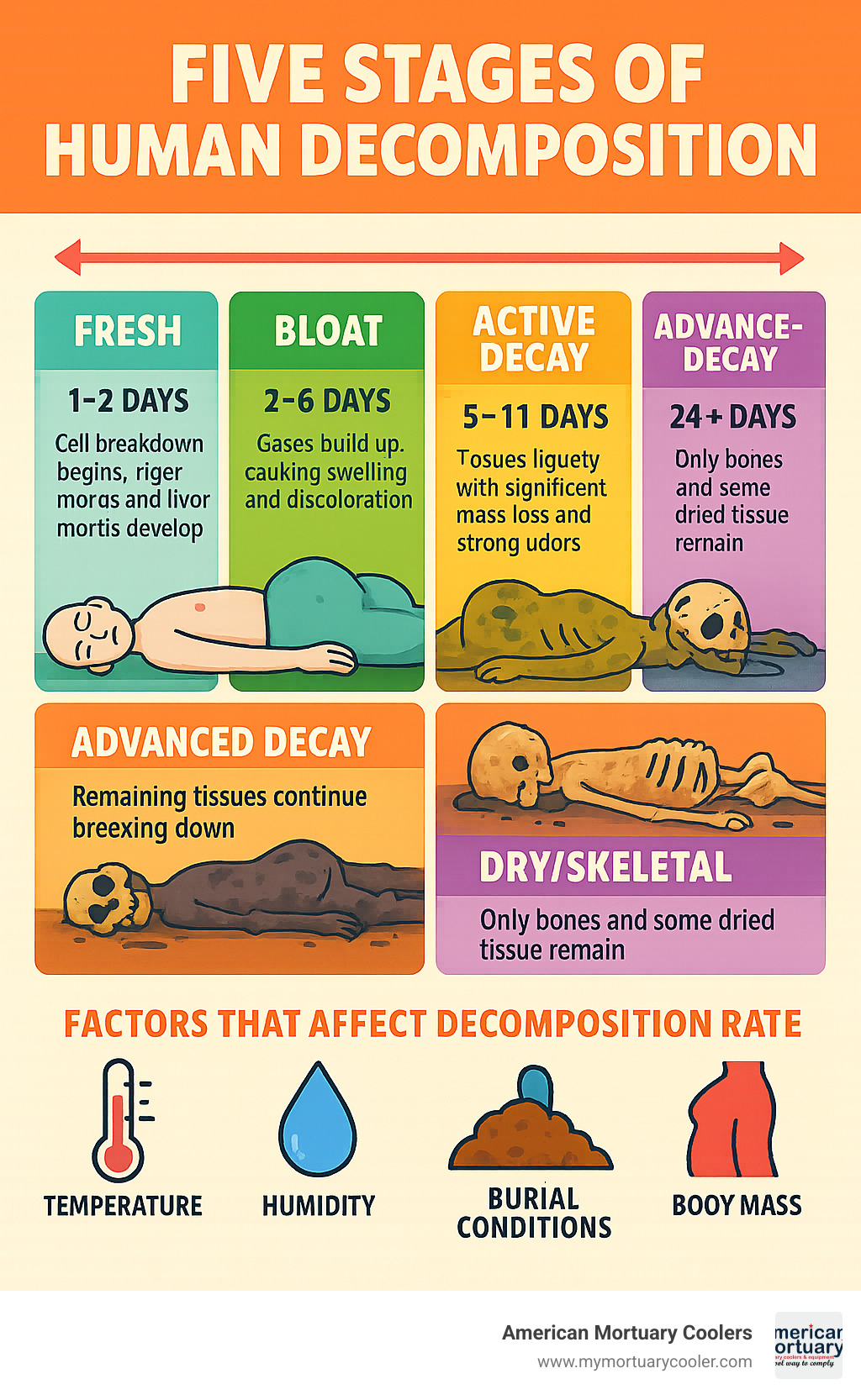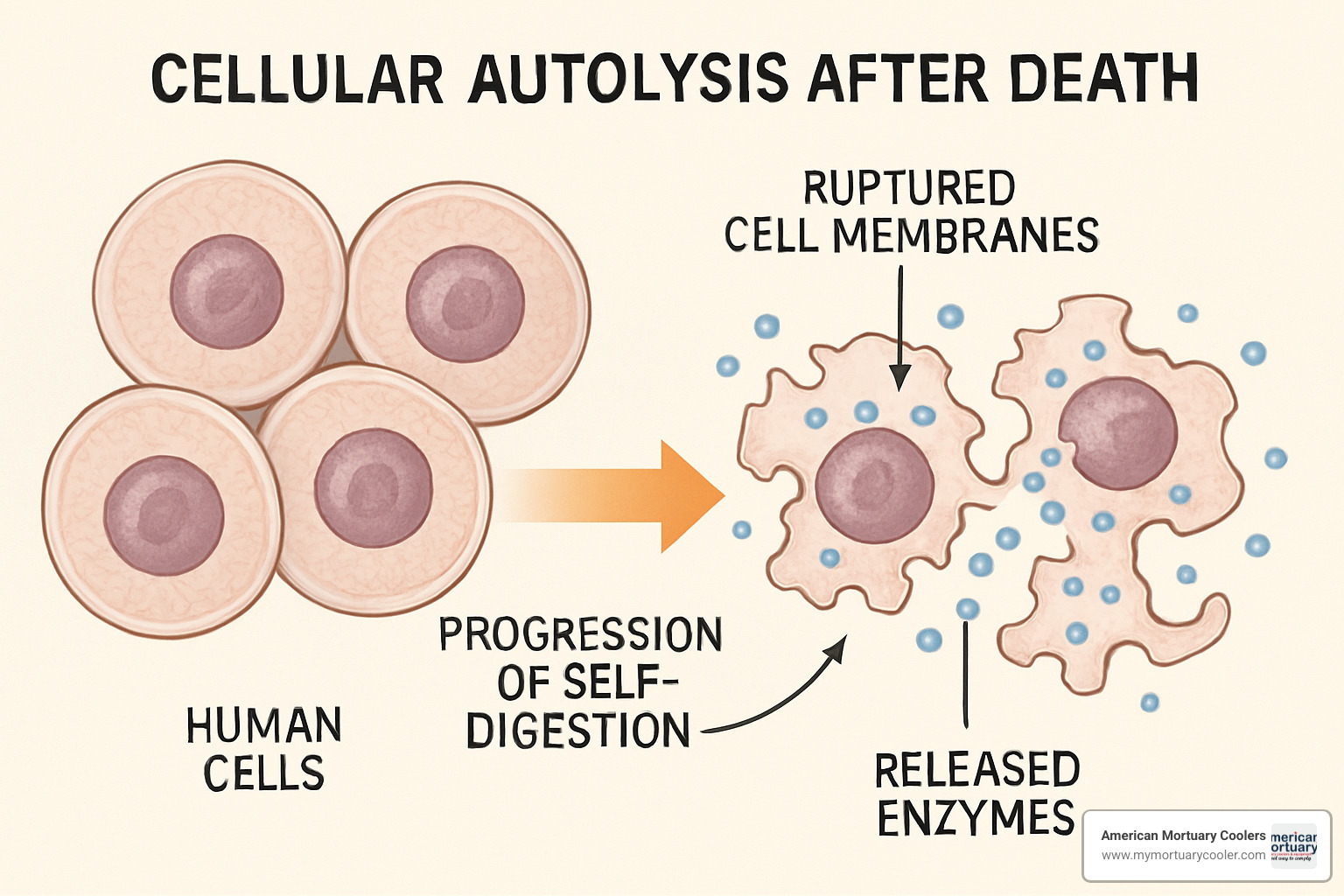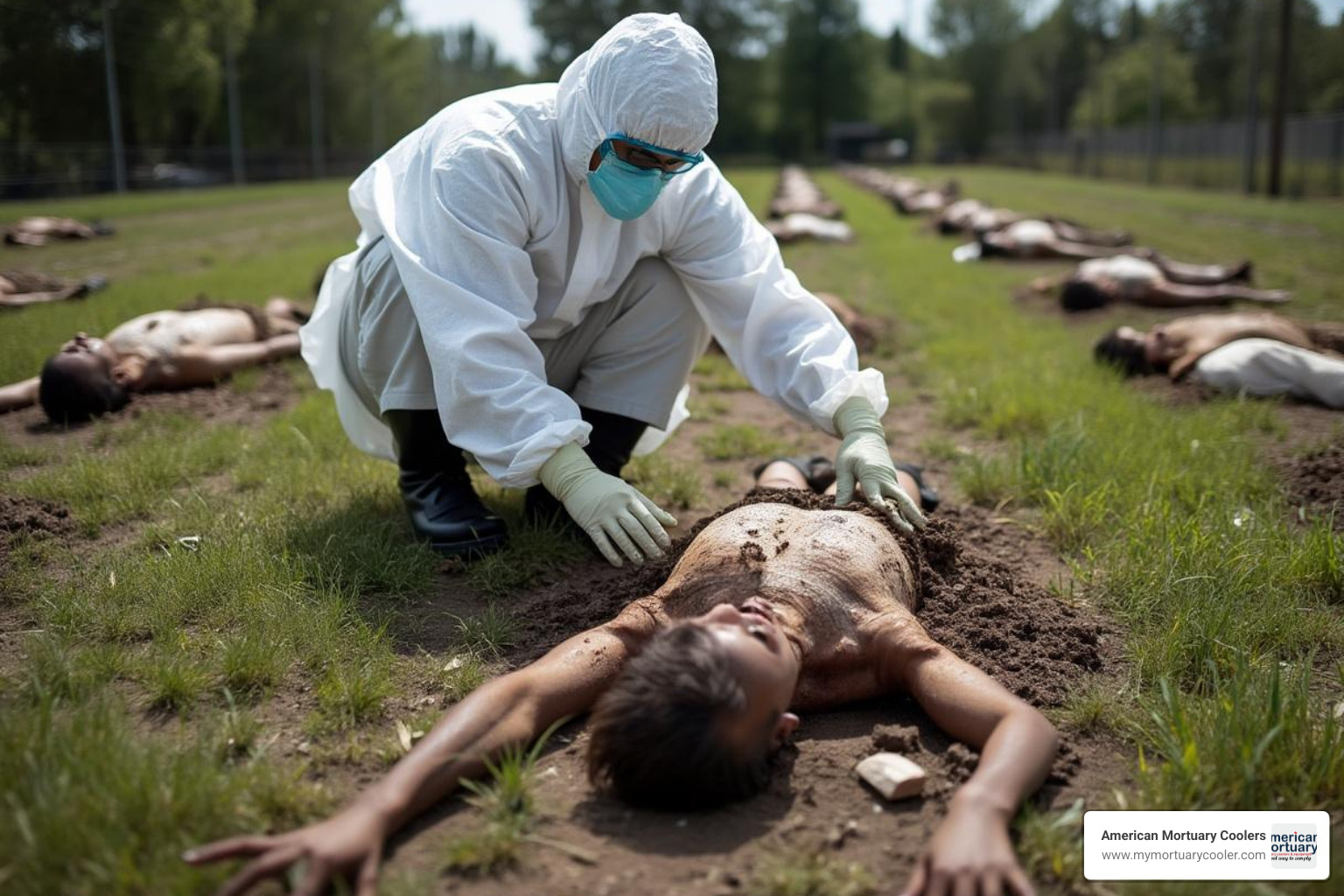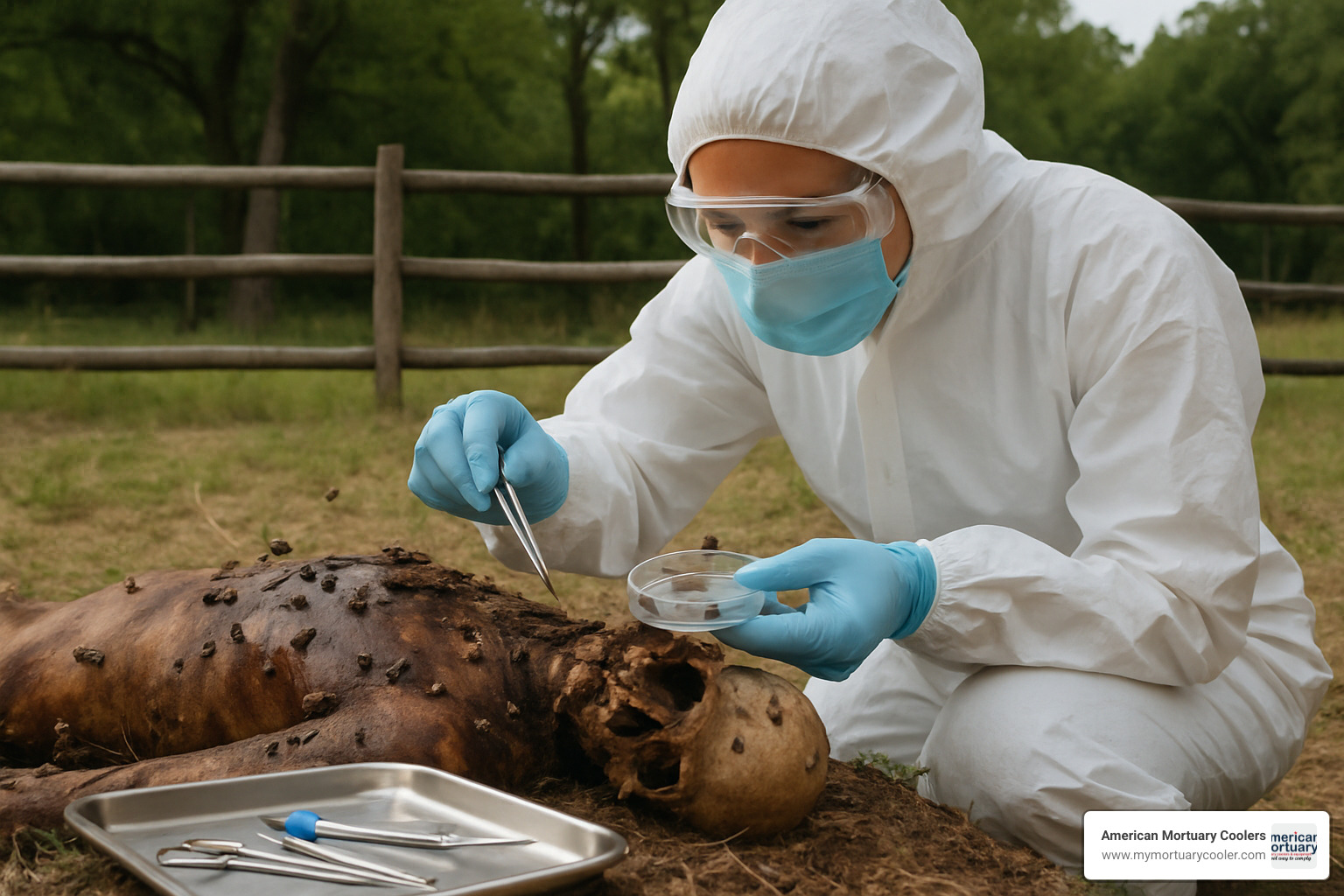Understanding the Natural Process of Human Decomposition
Decomposed bodies go through a predictable sequence of changes after death, following five main stages:
- Fresh stage (1-2 days): Cell breakdown begins, with rigor mortis and livor mortis developing
- Bloat stage (2-6 days): Gases build up, causing swelling and discoloration
- Active decay (5-11 days): Tissues liquefy with significant mass loss and strong odors
- Advanced decay (10-24 days): Remaining tissues continue breaking down
- Dry/skeletal (24+ days): Only bones and some dried tissue remain
The decomposition process begins approximately 4 minutes after death, when cells start to self-digest through autolysis. The rate varies based on temperature, humidity, and whether the body is buried, submerged, or exposed.
In forensic settings, decomposed bodies provide valuable information for determining time since death, circumstances surrounding death, and sometimes cause of death. Despite challenges, careful examination can identify cause of death in up to 98% of cases.
For funeral homes and medical facilities, proper refrigeration significantly slows decomposition, providing crucial time for families to make arrangements and for necessary examinations to take place.
I'm Mortuary Cooler, a national-level supplier of mortuary refrigeration systems with extensive experience helping funeral homes and medical examiners properly store and manage decomposed bodies.

What You'll Learn
In this comprehensive guide, we'll walk you through everything you need to know about decomposed bodies and the process of decomposition. This natural yet complex phenomenon affects approximately 15% of autopsies in some medicolegal centers, making it a significant consideration for funeral homes, medical examiners, and forensic investigators.
Despite the challenges that decomposition presents, skilled professionals can identify the cause of death in up to 98% of autopsies performed on decomposed adults when conducted with proper care and attention to detail. This guide aims to provide you with a clear understanding of:
- The biological processes that drive decomposition
- The five distinct stages bodies progress through after death
- Factors that accelerate or slow the decomposition process
- Forensic applications and challenges when working with decomposed remains
- Safety considerations and proper handling protocols
- Storage solutions to preserve dignity and prevent further decomposition
Understanding Decomposition: Processes and Early Changes
Death isn't the end of biological activity—it's the beginning of a fascinating change. When life ceases, the body starts a remarkable journey governed by precise biological processes.
Within minutes of death, autolysis—the body's self-digestion process—begins. As the heart stops, oxygen deprivation causes cells to suffocate. Carbon dioxide accumulates, pH levels drop, and toxic wastes build up. This increasingly acidic environment causes cell membranes to break down, releasing enzymes that begin digesting the cells from within. This process starts most rapidly in organs rich in enzymes—the liver, brain, and digestive tract.

As autolysis progresses, several visible changes mark the early hours after death. These changes, known as the "mortis triad," help establish when death occurred:
Algor mortis gradually cools the body to room temperature at roughly 1.5°F per hour. Pallor mortis brings paleness within 15-30 minutes as circulation halts. Meanwhile, livor mortis creates purplish discoloration in the lowest portions of the body as blood settles. This purple "staining" begins within 30 minutes to 2 hours and becomes permanently "fixed" after 8-12 hours.
Rigor mortis creates the characteristic stiffness we associate with death. Beginning 2-6 hours after death, muscles stiffen as cellular ATP depletes and calcium ions flood muscle fibers. This stiffening typically peaks around 12 hours post-mortem before gradually releasing over the next 24-84 hours.
As cellular barriers fail, bacteria that normally live in our intestines become opportunistic decomposers. Without the immune system to keep them in check, these microbes multiply rapidly and begin spreading through the body. This marks the beginning of putrefaction, usually starting 48-72 hours after death. Scientific research on autolysis has revealed fascinating details about these processes.
Decomposed Bodies: Key Early Signs
The early indicators of decomposition tell powerful stories to those who know how to read them. In decomposed bodies, several key changes emerge in those crucial first hours:
Muscle stiffness follows a predictable journey across the body. Rigor mortis typically begins with smaller muscles in the face and jaw before traveling downward to the neck, arms, trunk, and finally the legs.
Lividity patterns paint the body with distinctive purple-red brushstrokes where blood pools due to gravity. These patterns reveal secrets: if a body shows lividity on the back but is found face-down, investigators know it was moved after death.
Core temperature drop provides perhaps the most reliable early indicator of time since death. The body's cooling process follows a relatively predictable pattern in the first 24 hours. More info about morgue temperature explains how controlled cooling environments preserve bodies for examination.
Why Decomposed Bodies Smell the Way They Do
The distinctive odor of decomposed bodies results from volatile organic compounds (VOCs) released during tissue breakdown. This odor is so distinctive that trained cadaver dogs can detect it even when buried under concrete or submerged in water.
The primary compounds creating this smell are cadaverine and putrescine from protein breakdown. As decomposition advances, hydrogen sulfide contributes its "rotten egg" aroma, while skatole and indole add fecal notes to the unpleasant symphony.
This changing odor profile helps forensic investigators, as different stages of decomposition produce different dominant compounds, creating a timeline that helps establish when death occurred.
Microbial & Chemical Triggers
Decomposition is largely an inside job. While we might imagine external factors driving decay, much of the initial breakdown comes from within our own bodies.
The trillions of bacteria that normally inhabit our gut become the primary workforce of decomposition. These microbes, no longer controlled by our immune system, begin multiplying rapidly and spreading throughout the body via blood vessels. As they digest tissues, they produce gases that cause the characteristic bloating of decomposed bodies.
This interplay between chemical and microbial activity transforms a body from fresh remains to advanced decomposition surprisingly quickly. Proper refrigeration significantly slows these processes, which is why morgue temperature standards are so crucial for preserving dignity and enabling proper examination of the deceased.
The Five Stages of Decomposed Bodies
When someone passes away, their body begins a remarkable journey through decomposition. Decomposed bodies follow five distinct phases, though in reality, these stages often blend together with different body parts decomposing at different rates.
Research facilities known as "body farms" have carefully documented these stages using donated human remains or pig models (whose decomposition closely mirrors human patterns).

Stage 1 – Fresh
The fresh stage begins at the moment of death and typically lasts 1-2 days. Despite being called "fresh," profound changes are already happening beneath the surface.
Within minutes of the heart stopping, cells begin their death cascade. Brain cells suffer permanent damage after just 3-5 minutes without oxygen. Meanwhile, self-digestion (autolysis) accelerates, especially in organs rich in enzymes like the pancreas, liver, and stomach.
During this stage, the three classic post-mortem changes – the "mortis triad" – develop. The body cools (algor mortis), muscles stiffen (rigor mortis), and blood settles to create purplish discoloration in lower-lying areas (livor mortis).
The fresh stage ends when bacteria begin producing enough gas to cause visible swelling, and the first hints of greenish discoloration appear, typically starting in the lower right abdomen.
Stage 2 – Bloat
Around 2-3 days after death, the bloat stage begins, lasting until approximately day 6. This phase brings the most visually distinctive changes to decomposed bodies.
The bloating occurs because bacteria metabolizing tissues produce gases – hydrogen sulfide, carbon dioxide, methane, and nitrogen – that have nowhere to escape. This causes significant swelling, starting in the abdomen and genitals before spreading throughout the body.
The skin develops a marbled appearance as bacteria-filled blood vessels become visible. The initial green discoloration in the abdomen spreads to other areas. If flies have had access, their eggs begin hatching, and maggots start feeding on tissues.
This stage presents particular challenges for funeral homes and medical examiners. Proper refrigeration becomes crucial to slow bacterial activity and preserve dignity.
Stage 3 – Active Decay
Active decay represents the period of most dramatic tissue breakdown, typically occurring between 5-11 days after death. This stage begins as gases escape from the body and brings profound changes.
Tissues liquefy as enzymes and bacteria continue their work. The body loses a substantial portion of its mass during this stage as fluids purge from the body and soft tissues collapse. A dark, foul-smelling liquid called purge fluid seeps into the surrounding environment.
The characteristic odor of decomposed bodies reaches peak intensity during active decay. If insects have access, large masses of maggots can be observed actively consuming soft tissues.
Stage 4 – Advanced Decay
Between 10-24 days after death, decomposed bodies enter advanced decay. During this quieter but still active stage, the remaining soft tissues continue breaking down, though most of the body's mass has already been lost.
Under certain conditions – particularly in moist environments with limited oxygen – body fats may undergo saponification, forming adipocere or "grave wax," a waxy, soap-like substance that can preserve body features for extended periods.
The soil beneath the body shows liftd nutrient levels during this stage. As soft tissues become depleted, the insect populations shift – beetles and other insects that feed on drier materials replace flies.
Stage 5 – Skeletonization
The final stage begins around 24+ days after death, though complete skeletonization can take months or even years depending on environmental conditions. During this phase, remaining soft tissues continue to break down, exposing more of the skeleton.
Even bones begin to decompose as their organic component (collagen) breaks down, leaving only the mineral structure. Environmental factors cause cracking, flaking, and bleaching of exposed bones.
In extreme environments, complete skeletonization can occur in as little as a week in hot, humid conditions with insect access. In cold or very dry conditions, or when buried deeply, this process might take years.
Even in this final stage, skeletal remains can provide valuable forensic information about the individual's age, sex, stature, ancestry, and potential trauma or pathological conditions.
Variables That Accelerate or Slow Decay
When it comes to decomposed bodies, nature doesn't follow a rigid timeline. The journey from death to skeletonization is remarkably variable, influenced by a complex interplay of environmental and physical factors.

Temperature stands out as perhaps the most influential factor. As a rule of thumb, decomposition speeds up approximately twice as fast with each 10°C (18°F) increase in temperature. This explains the dramatic differences across climates—a body might reach skeletonization in just over a week in hot, humid environments while taking months in colder regions.

The environment surrounding decomposed bodies creates a unique microclimate. Humidity and moisture play a dual role—moderate moisture supports bacterial growth and insect activity, while extremely dry conditions can lead to natural mummification as tissues dehydrate before bacteria can break them down.
Burial depth offers protection from the elements, with deeper burials typically slowing decomposition. Bodies at depths of 4 feet or more can retain soft tissues for a year or longer due to limited oxygen, reduced insect access, and more stable temperatures. Similarly, water submersion generally halves the decomposition rate compared to air exposure.
Even clothing and coverings play their part. They might accelerate decomposition by creating warm, moist environments favorable to bacteria, or alternatively, slow it by limiting insect access to the body.
The physical characteristics of the deceased also influence decomposition timing. Body mass and composition matter significantly—larger bodies with more adipose (fat) tissue generally decompose more rapidly due to higher water content and increased bacterial activity. Trauma and wounds create entry points for insects and bacteria, potentially accelerating decomposition in affected areas.
Insects and scavengers dramatically speed the return of a body to the earth. Flies and their larvae (maggots) can accelerate decomposition to such a degree that bodies without insect access decompose approximately eight times slower than those with insect activity.
Rapid Decay Scenarios
Certain conditions create perfect storms for accelerated decomposition, presenting unique challenges for funeral homes and medical examiners.
Tropical heat creates ideal conditions for bacterial growth and insect activity. In these warm, humid environments, a body can progress to active decay in just 24 hours and reach skeletonization in as little as 7-10 days.
Obesity provides more resources for decomposition. Higher body mass, particularly fat tissue, fuels bacterial growth and generates additional heat during decomposition.
Bodies fighting sepsis or fever at time of death already have liftd bacterial loads and higher temperatures, essentially giving decomposition a head start.
Even insulating bedding or clothing can significantly impact decomposition rates by creating microenvironments that accelerate bacterial growth.
Natural Preservation Paths
While decomposition eventually claims all things, certain conditions can dramatically slow the process or create remarkable forms of natural preservation.
Cold environments act as nature's preservative. Low temperatures significantly reduce bacterial activity, and in extreme cases like frozen environments, decomposition can essentially halt, preserving bodies for decades or even centuries.
Extreme drought leads to natural mummification as tissues dehydrate before bacteria can break them down. This process preserves skin, hair, and even internal organs in a dried state.
Embalming dramatically slows decomposition by killing bacteria and fixing tissues. Modern embalming techniques can preserve bodies for weeks to months, depending on the methods used and environmental conditions.
In wet, oxygen-poor environments, adipocere formation can occur. Body fats undergo saponification, converting to a waxy substance called "grave wax" that can preserve body features for decades or even centuries.
Bog preservation represents one of the most extraordinary natural preservation methods. Bodies deposited in peat bogs can undergo exceptional preservation due to the acidic, oxygen-poor environment and the presence of tannins.
Human Intervention: Refrigeration & Cooling
In modern death care, refrigeration remains the most practical and widely used method for slowing decomposition. Research shows that cooling bodies to temperatures between 36°F and 39°F (2°C and 4°C) significantly inhibits bacterial growth and enzymatic activity.
At American Mortuary Coolers, we've dedicated ourselves to understanding the science behind temperature control and decomposition. Our refrigeration solutions maintain these optimal temperatures consistently, providing funeral homes and medical examiners with reliable systems that:
- Keep temperatures stable even when frequently accessed
- Provide even cooling throughout the storage space
- Operate reliably in various climates and conditions
- Include backup systems to prevent decomposition during power failures
While refrigeration doesn't stop decomposition entirely, it dramatically slows the process. Bodies can typically be preserved in refrigerated conditions for 1-2 weeks before noticeable decomposition begins to occur.
For more detailed information about the limitations of refrigeration in preserving human remains, you can explore our article on refrigeration limits.
Forensics & Public Health: Working With Decomposed Bodies
Working with decomposed bodies might sound challenging, but for forensic professionals, these remains tell compelling stories. Despite their altered state, they offer valuable insights about identity, when the person died, and often how they died.
One of the most crucial pieces of information investigators need is the post-mortem interval—how long has the person been deceased? To solve this puzzle, experts use several complementary approaches:
They analyze the stage of decomposition, study the insects colonizing the body, examine biochemical markers that change predictably after death, and look at how the surrounding environment has been altered by the decomposition process.
Forensic entomology has revolutionized time-since-death estimates. Nature follows reliable patterns, with different insects arriving at bodies in a predictable sequence. By identifying which bugs are present and their developmental stage, while factoring in weather conditions, experts can often pinpoint when death occurred with surprising accuracy.

The humble blowfly provides particularly valuable evidence. These insects typically arrive within minutes of death, and their life cycle follows a temperature-dependent timeline that's well understood.
Modern forensic science continues to expand our ability to learn from decomposed bodies. DNA can often be recovered even from significantly decomposed remains, particularly from teeth, bones, and hair roots. Post-mortem CT scanning (PMCT) reveals internal injuries that might be invisible during traditional autopsy. Even advanced toxicology can detect drugs and poisons after substantial decomposition has occurred.
Estimating Time Since Death
"When did this person die?" This seemingly simple question becomes increasingly complex as decomposition advances. Fortunately, forensic scientists have developed multiple approaches to narrow down the timeline.
The accumulated degree-days (ADD) method recognizes that decomposition progresses faster in warmer conditions. By documenting the stage of decomposition and knowing the temperature history at the scene, investigators can estimate how long the body has been decomposing with greater accuracy.
Insect evidence provides some of our most reliable timeline indicators. Finding third-instar fly larvae (maggots) allows investigators to work backward from their known development rate to calculate when eggs were likely laid—typically within hours of death.
The soil beneath a body also holds temporal clues. As decomposition progresses, bodies release nutrients and chemicals into the soil in predictable patterns.
Even after death, certain biochemical processes continue at measurable rates. The potassium concentration in the eye's vitreous fluid, for instance, increases predictably after death, providing another timeline marker.
Challenges During Autopsy of Decomposed Bodies
Performing autopsies on decomposed bodies requires special skills and determination. Despite significant challenges, a careful, systematic approach yields valuable information in up to 98% of cases.
Decomposition creates numerous complications for medical examiners. Putrefactive gases can mimic certain medical conditions. Skin and tissues separate and slip, making handling difficult and potentially obscuring injuries. Normal post-mortem discoloration can mask or mimic bruising. Internal organs may partially or completely liquefy, complicating examination.
Experienced forensic pathologists overcome these obstacles through methodical approaches and specialized techniques. They might use cloths or sponges to handle slippery tissues, collect samples for laboratory testing early in the examination, and carefully document insect activity before removal.
At American Mortuary Coolers, we partner with medical examiners to provide refrigeration solutions that slow decomposition and help preserve evidence, giving forensic professionals optimal conditions for their vital work.
Decomposed Bodies and Scene Safety
Working with decomposed bodies presents significant health and safety challenges that require proper precautions. Decomposition creates various hazards that professionals must manage carefully.
Bioaerosols—airborne biological particles that can carry pathogens—are released during decomposition and pose respiratory risks. Bone fragments can be surprisingly sharp, capable of penetrating gloves and skin. The chemical cocktail produced during decomposition includes hydrogen sulfide gas, which can be deadly in high concentrations.
Proper safety protocols are essential when handling decomposed remains. This starts with appropriate personal protective equipment (PPE), typically including impermeable gowns, double gloves, face shields, and respirators with filters designed for organic vapors. Managing the strong odors associated with decomposition requires effective ventilation systems, activated charcoal filters, and sometimes masking agents.
Thorough cleaning and disinfection of all surfaces and equipment after contact with decomposed remains is non-negotiable. Proper training for personnel and rotating staff to limit exposure helps protect both physical and mental health.
At American Mortuary Coolers, we build safety features into our mortuary refrigeration systems, including proper ventilation, easy-to-clean surfaces, and reliable backup systems to ensure continuous operation. Our safety protocols are designed to create a safer working environment for those handling decomposed remains.
Conclusion & Preservation Solutions
When it comes to human remains, understanding decomposition isn't just academic—it's practical knowledge that guides everything from funeral services to forensic investigations. The natural processes we've explored throughout this article affect how we care for the deceased with dignity and respect.
Here at American Mortuary Coolers, we're proud to serve funeral homes and medical examiners across the contiguous 48 states from our Tennessee home base. We've dedicated ourselves to creating refrigeration solutions that address the unique challenges that come with preserving human remains.
Our approach isn't one-size-fits-all because we understand that every facility has different needs. Instead, we build custom mortuary coolers designed with features that make a real difference:
We maintain that sweet spot temperature range of 36°F-39°F—cool enough to dramatically slow bacterial growth without causing tissue damage from freezing. Our systems ensure this temperature remains consistent throughout the entire storage space.
Even in challenging conditions—like summer heat waves or winter storms—our coolers keep running reliably. And because we know that power outages happen, we include backup systems to prevent decomposition during those critical moments when electricity fails.
The reality of working with decomposed bodies means sanitation is non-negotiable, so we design our units with surfaces that are easy to clean and disinfect thoroughly.
There's something deeply meaningful about providing families the time they need to say goodbye properly. Our refrigeration solutions help funeral homes give that gift of time—preserving the dignity of the deceased while arrangements are made and loved ones gather.
For medical examiners and forensic professionals, proper refrigeration creates the conditions needed for thorough examinations, helping ensure that evidence is preserved and justice can be served.
Key Takeaways
The journey of decomposed bodies follows a complex but predictable path, influenced by many factors but guided by universal biological principles:
Death marks the beginning of decomposition, not the end of a story. Within minutes, cells begin their self-digestion process through autolysis, setting the stage for everything that follows.
The five stages we've explored—fresh, bloat, active decay, advanced decay, and skeletonization—provide a roadmap for understanding what happens and when. This framework helps professionals anticipate changes and respond appropriately.
Mother Nature plays favorites when it comes to decomposition speed. Temperature stands out as the most powerful influence, with humidity, insect access, and body composition following closely behind.
Despite the challenges they present, decomposed bodies still speak volumes to those trained to listen. Skilled forensic professionals can determine cause of death in up to 98% of cases when they apply proper techniques and understanding.
Working with decomposed remains requires serious safety protocols to protect against biological, chemical, and psychological hazards.
Refrigeration at 36°F-39°F remains our most practical tool for slowing decomposition in funeral homes and medical facilities, buying precious time for families and investigators alike.
While we can't stop decomposition forever, understanding its mechanisms allows us to manage it with care and respect. At American Mortuary Coolers, we're committed to supporting death care professionals with high-quality refrigeration solutions that preserve dignity, protect health, and honor the important work of caring for those who have passed.
For more information about how our custom mortuary coolers can help your facility handle decomposition challenges with confidence, please reach out to our team. We're ready to serve you from our regional locations in Johnson City TN, Atlanta GA, Chicago IL, Columbia SC, Dallas TX, Los Angeles, New York NY, and Pittsburgh PA.
















